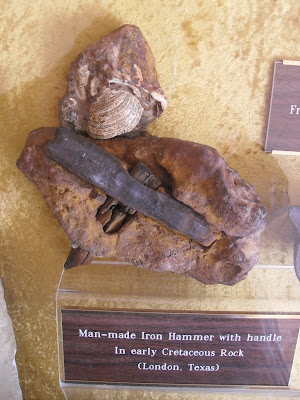The London Hammer also became known as the "London artifact" is the name given to a hammer made of iron and wood embedded in the Lower Cretaceous limestone. How is it possible that man-made instruments encased inside an ancient rock never rust, even though their wood turns to coal?
In 1936, Max and Emma Hahn, the Texas couple took a hike along Red Creek near London (a tiny community located in the center of the Lone Star State), Texas. They spotted a curious piece of loose rock with a bit of wood embedded in it and took it home with them. A decade later, their son Max broke open the rock to find the concealed hammerhead within. The rock surrounding the hammer is said to be more than 100 million years old, suggesting the hammer was made well before humans who could have made such an object are thought to have existed.
 |
| The London Hammer. Image credit: Wikipedia |
The physical facts of London Hammer are as follows:
- The metal hammerhead is approximately 15 centimeters long and has a diameter of 25 mm.
- The metal is made up of 96.6% iron, 2.6% chlorine, and 0.74% sulfur.
- The iron head has not rusted since it was discovered in 1936.
- The wooden handle is unmineralized with small traces of carbonization
- While the exact discovery location has not been verified, the lack of sharp nicks seems to confirm that it was not chiseled from a larger rock formation, but found loose, as the Hahns claimed.
Nearly four decades, the hammer remained a local oddity and relatively unknown, until in 1983, it came to the attention of Carl Edward Baugh (Carl Baugh), a Young Earth creationist. Later became the founder and Director of Creation Evidence Museum, Glen Rose, Texas.
So he bought it, and examined the mysterious object. He claimed the artifact was a "monumental 'pre-Flood' discovery."
 |
| Dr. Carl Baugh. Image credit: Creationwiki |
Baugh later wrote an article which was published in the Bible-Science Newsletter in 1983 and promote it as the "London artifact".
At that time Baugh not release the artifact for independent testing. He has had it tested by himself.
 |
| London Hammer inside Baugh Museum. Image credit: Stanley A. Rice |
Other observers have noted that the hammer is stylistically consistent with typical American tools manufactured in the region in the late 19th century. Its design is consistent with a miner's hammer which means that this hammer was not used for large projects, but rather for fine work or soft metal.
There are many who doubt where the hammer was supposedly found; others claim the rock formation is consistent with the minerals and sediments of the surrounding area, putting the claim of the rock dating back to hundreds of millions of years ago in doubt. Others claim that the hammer could have been discarded and the rock formation occurred through the natural process of petrification.
Despite some creationist assertions that the hammer is a pre-Flood relic, no clear evidence linking the hammer to any ancient formation has been presented. Moreover, the hammer's artistic style and the condition of the handle suggest a historically recent age. It may well have been dropped by a local worker within the last few hundred years, after which dissolved sediment hardened into a concretion around it. Unless Baugh or others can provide rigorous evidence that the hammer was once naturally situated in a pre-Quaternary stratum, it remains merely a curiosity, not a reliable out-of-place artifact.
References:
==========================================================================








Please don't put your website link in Comment section. This is for discussion article related only. Thank you :)